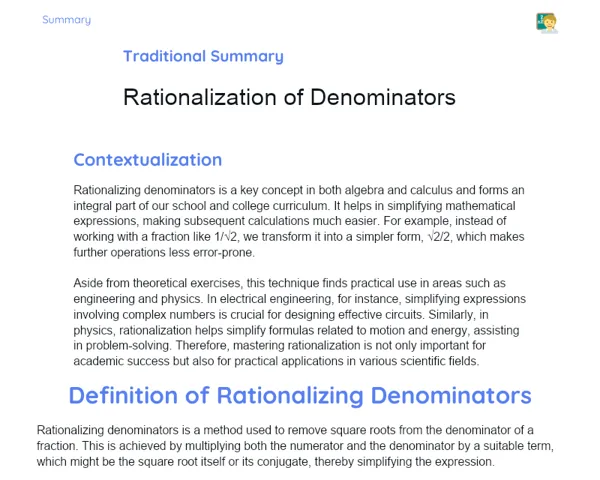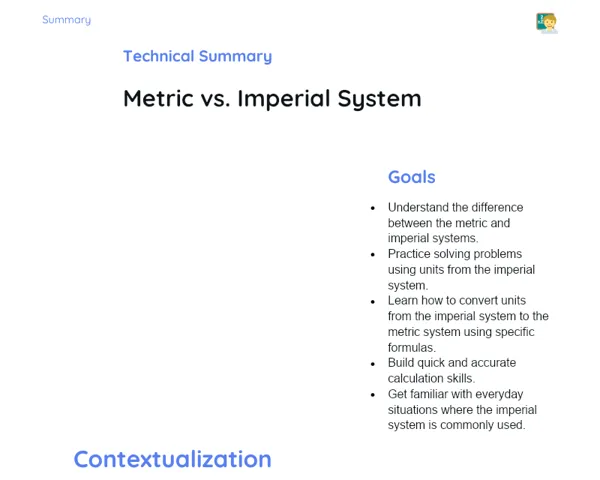Objectives
1. 🎯 Get a clear idea of absolute value and see how it differs from the usual value of a number.
2. 🎯 Learn to calculate the absolute value for any number, be it positive or negative.
3. 🎯 Enhance your skills in arranging rational numbers in both ascending and descending order using absolute value as a benchmark.
4. 🎯 Understand and work with negative numbers across various mathematical problems and everyday scenarios.
Contextualization
Did you know that the idea of absolute value is much more than just a number crunching exercise? It comes into play in everyday life – for example, in navigation where GPS coordinates use negative numbers to indicate different directions, in physics while measuring displacements, and even in music where the gap between notes is measured using whole numbers. Grasping absolute value not only strengthens your maths foundation but also helps you interpret everyday situations more effectively!
Important Topics
Absolute Value
Absolute value refers to the distance a number is from zero on a number line, without considering the direction. For instance, the absolute value of 5 is 5 since it's exactly 5 units from zero. In the same vein, even though -5 lies on the opposite side, its absolute value is also 5 because the distance remains the same.
-
The absolute value of a number is always non-negative — that is, it is either zero or positive.
-
It is denoted by two vertical bars, |x|, where x is the number you’re evaluating.
-
This concept simplifies calculations in many mathematical expressions and is crucial for topics in geometry and physics.
Ordering Rational Numbers
This involves arranging numbers in a sequence — either from smallest to largest or vice versa. When ordering, we consider the absolute values to decide their positions. For example, in the series -3, 4, -1, 2, observe that -3 and -1 have absolute values 3 and 1 respectively, which you compare with 2’s absolute value of 2. Consequently, the numbers in order become -3, -1, 2, 4.
-
Absolute value plays a key role in comparing positive and negative numbers to set them in the correct order.
-
In real life, ordering numbers finds applications in areas like finance, where one may need to sort out various incomes and expenses.
-
By understanding how to order numbers, we sharpen our analytical abilities and improve decision-making.
Negative Numbers
Negative numbers represent values less than zero and are a fundamental part of both mathematics and science. They come into play when dealing with scenarios like debts, sub-zero temperatures, or movements in the opposite direction. Having a solid grasp over negative numbers is essential for solving equations and modelling real-life phenomena.
-
Negative numbers complete the set of rational numbers, making operations such as subtraction and division possible.
-
They’re commonly seen in everyday matters, like managing bank balances or understanding loan statements.
-
The idea of negative numbers is universal, forming a core part of different numeral systems worldwide.
Key Terms
-
Absolute Value: It is the measure of the distance of a number from zero on a number line and is always non-negative.
-
Ordering Rational Numbers: It means arranging numbers based on their size, often by comparing their absolute values.
-
Negative Numbers: Numbers that indicate values below zero and are crucial for various mathematical operations and everyday use.
For Reflection
-
How can understanding absolute value help in day-to-day activities like shopping or calculating discounts?
-
Why is it important to be comfortable with negative numbers in maths and science subjects?
-
In what ways can arranging rational numbers be useful outside the classroom, such as when planning your day or managing schedules?
Important Conclusions
-
We revisited the concept of absolute value, noting that it represents the distance from zero and is always zero or positive.
-
We learned how to order rational numbers by comparing their absolute values, a skill that's vital in both practical and academic contexts.
-
We discussed the significance of negative numbers in representing values below zero, underscoring their importance in mathematics, science, and everyday life.
To Exercise Knowledge
- Prepare a shopping list for your daily needs. Calculate the total cost while considering any discounts or mark-ups and verify your results using absolute value. 2. Draw a number line, marking both positive and negative numbers. Practice arranging the numbers and explain your reasoning. 3. Imagine a board game where the dice roll decides whether you move forward or backward. Use the dice to practice adding and subtracting negative numbers.
Challenge
Numerical Maze Challenge: Create a small maze on paper and label each cell with a number. Choose a path that involves operations using absolute value and ordering numbers to exit the maze. Share your maze with a friend and see if they can solve it using the concepts you’ve learned!
Study Tips
-
Practice plotting absolute values on a number line regularly to improve your visual understanding of maths concepts.
-
Engage with interactive math games and apps that incorporate negative numbers and absolute value for a fun learning experience.
-
Relate the concept of absolute value to everyday scenarios like map distances or temperature readings to see its practical applications.


